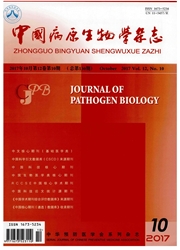

 中文摘要:
中文摘要:
目的探讨日本血吸虫中国大陆株23ku膜蛋白分子大亲水肽段(Sj23HD)的抗体反应模式及重组Sj23HD-HSA用于血吸虫诊断和疗效考核的价值。方法建立血吸虫尾蚴感染小鼠及家兔模式动物。采集尾蚴感染前、感染后及治愈后不同时间点小鼠及家兔血清,以酵母表达的纯重组Sj23HD蛋白为抗原,通过间接ELISA方法检测抗Sj23HD IgG应答水平的动态变化,观察Sj23HD在小鼠及家兔体内的抗体反应应答模式及其疗效考核潜能;以Sj23HD-HSA融合蛋白为抗原,以ELISA检测132份血吸虫、30份华支睾吸虫、10份并殖吸虫感染者以及80份健康人血清,观察该重组抗原用于血吸虫病诊断的价值,以抗可溶性虫卵抗原的抗体应答反应作为对照。结果血吸虫感染小鼠及家兔体内抗Sj23HD蛋白的抗体反应呈短寿应答模式,抗Sj23HD IgG反应随着感染时间的延长呈增强趋势,治愈后的初期继续增强,至治疗后2~4周达到最高水平,随后逐渐下降,至治疗后16周,部分小鼠、家兔的抗体水平可达到阴性阈值,但下降幅度存在个体差异;抗SEA抗体水平在治疗后呈轻度下降趋势。未治疗小鼠和家兔血清中抗Sj23HD、SEA的抗体水平均无明显下降。重组Sj23HD-HSA和SEA ELISA检测132份血吸虫病病人血清,特异抗体阳性率分别为88.64%和97.73%;检测10份并殖吸虫病病人血清,交叉反应率为50%和90%;检测30份华支睾吸虫病病人血清,交叉反应率为0和16.7%;80份健康人血清检测均为阴性。结论血吸虫感染小鼠、家兔血清中抗Sj23HD蛋白的抗体反应为抗原依赖的短寿抗体反应,检测参与这一特异性短寿抗体反应的抗体具有血吸虫病诊断与疗效考核潜能。与SEA相比,重组Sj23HD蛋白作为抗原用于血吸虫病实验诊断具有较好的特异性,但对于来自并殖吸虫流行区的患者仍需注意鉴别诊断。
 英文摘要:
英文摘要:
Objectives To investigate the pattern of antibody response to a large hydrophilie domain of a 23-ku mem-brane protein in mice and rabbits infected with Schistosoma japonicum and determine the value of the recombinant fusion protein Sj23HD-HSA in diagnosing schistosomiasis japonica and evaluating its treatments. Methods Animal models were established using mice and rabbits infected with schistosome cercariae. The sera of mice and rabbits infected with S. japonicurn were collected at different times before infection, during infection, and after treatment with PZQ. To observe the pattern of antibody response to Sj23HD in mice and rabbits infected with S. japonicum and evaluate the potential therapeutic effectiveness of a fusion protein in treating schistosomiasis, an indirect enzyme-linked immunosorbent assay (ELISA) was used to determine the dynamics of antibody response to Sj23HD at different times before infection, during infection, and after treatment with PZQ. To evaluate the immunodiagnostic value of recombinant Sj23HD-HSA, ELISA was performed on 132 serum specimens from patients with schistosomiasis, 30 serum specimens from patients with clonorchiasis, 10 serum specimens from patients with paragonimiasis, and 80 serum specimens from healthy individuals. As a control, antibodies (IgG) to soluble egg antigens (SEA) in sera were detected using indirect ELISA. Results The antibody response to Sj23HD increased as the duration of infection increased. It continued to rise and peaked 2-4 wks af-ter PZQ treatment. It then gradually declined. The level of antibody response in some mice and rabbits reached the nega-tive cut-off value 16 wks after PZQ treatment, but the extent of the decline in antibody response differed in different ani mals. There was a slight decline in the antibody response to SEA in treated mice and rabbits, but there was no decline in the antibody response to Sj23HD and SEA in untreated mice and rabbits. The 132 serum specimens from patients with schistosomiasis tested positive for anti
 同期刊论文项目
同期刊论文项目
 同项目期刊论文
同项目期刊论文
 Monitoring specific antibody responses against the hydrophilic domain of the 23 kDa membrane protein
Monitoring specific antibody responses against the hydrophilic domain of the 23 kDa membrane protein Detection of the circulating antigen 14-3-3 protein of Schistosoma japonicum by time-resolved fluoro
Detection of the circulating antigen 14-3-3 protein of Schistosoma japonicum by time-resolved fluoro Characterization of IgG responses of rabbits to Sj14-3-3 protein after experimental infection with S
Characterization of IgG responses of rabbits to Sj14-3-3 protein after experimental infection with S 期刊信息
期刊信息
